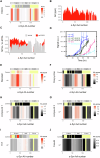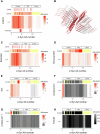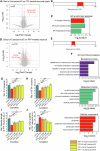An approach to characterize mechanisms of action of anti-amyloidogenic compounds in vitro and in situ
- PMID: 40348747
- PMCID: PMC12065871
- DOI: 10.1038/s41531-025-00966-5
An approach to characterize mechanisms of action of anti-amyloidogenic compounds in vitro and in situ
Abstract
Amyloid aggregation is associated with neurodegenerative disease and its modulation is a focus of drug development. We developed a chemical proteomics pipeline to probe the mechanism of action of anti-amyloidogenic compounds. Our approach identifies putative interaction sites with high resolution, can probe compound interactions with specific target conformations and directly in cell and brain extracts, and identifies off-targets. We analysed interactions of six anti-amyloidogenic compounds and the amyloid binder Thioflavin T with different conformations of the Parkinson's disease protein α-Synuclein and tested specific compounds in cell or brain lysates. AC Immune compound 2 interacted with α-Synuclein in vitro, in intact neurons and in neuronal lysates, reduced neuronal α-Synuclein levels in a seeded model, and had protective effects. EGCG, Baicalein, ThT and doxycycline interacted with α-Synuclein in vitro but not substantially in cell lysates, with many additional putative targets, underscoring the importance of testing compounds in situ. Our pipeline will enable screening of compounds against any amyloidogenic proteins in cell and patient brain extracts and mechanistic studies of compound action.
© 2025. The Author(s).
Conflict of interest statement
Competing interests: AC Immune (ACI) provided two of the compounds used in the study and Ait-Bouziad, N., Davranche, A., Boudou, C., Tsika, E., Ouared, A., and Stöhr, J. are employees of ACI. LiP-MS is subject of a patent licensed to the company Biognosys. The other authors declare no competing interests.
Figures







Similar articles
-
Exploring the Structural Diversity in Inhibitors of α-Synuclein Amyloidogenic Folding, Aggregation, and Neurotoxicity.Front Chem. 2018 May 25;6:181. doi: 10.3389/fchem.2018.00181. eCollection 2018. Front Chem. 2018. PMID: 29888220 Free PMC article.
-
How oxidized EGCG remodels α-synuclein fibrils into non-toxic aggregates: insights from computational simulations.Phys Chem Chem Phys. 2023 Jul 19;25(28):19182-19194. doi: 10.1039/d3cp02261g. Phys Chem Chem Phys. 2023. PMID: 37431676
-
Crosstalk Between Alpha-Synuclein and Other Human and Non-Human Amyloidogenic Proteins: Consequences for Amyloid Formation in Parkinson's Disease.J Parkinsons Dis. 2020;10(3):819-830. doi: 10.3233/JPD-202085. J Parkinsons Dis. 2020. PMID: 32538869 Free PMC article. Review.
-
Inhibitory effect of mitoquinone against the α-synuclein fibrillation and relevant neurotoxicity: possible role in inhibition of Parkinson's disease.Biol Chem. 2021 Oct 15;403(3):253-263. doi: 10.1515/hsz-2021-0312. Print 2022 Feb 23. Biol Chem. 2021. PMID: 34653323
-
Phthalocyanines as Molecular Scaffolds to Block Disease-Associated Protein Aggregation.Acc Chem Res. 2016 May 17;49(5):801-8. doi: 10.1021/acs.accounts.5b00507. Epub 2016 May 2. Acc Chem Res. 2016. PMID: 27136297 Review.
References
-
- Spillantini, M. G. et al. Alpha-synuclein in Lewy bodies. Nature388, 839–840, 10.1038/42166 (1997). - PubMed
-
- Glenner, G. G. & Wong, C. W. Alzheimer’s disease: initial report of the purification and characterization of a novel cerebrovascular amyloid protein. Biochem. Biophys. Res. Commun.120, 885–890, 10.1016/s0006-291x(84)80190-4 (1984). - PubMed
-
- Lunkes, A. et al. Proteases acting on mutant huntingtin generate cleaved products that differentially build up cytoplasmic and nuclear inclusions. Mol. Cell10, 259–269, 10.1016/s1097-2765(02)00602-0 (2002). - PubMed
LinkOut - more resources
Full Text Sources

